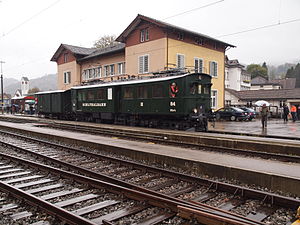SiTB CFe 2/4
| CFe 2/4 / BFe 2/4 / BDe 2/4 (Be 2/4) | |
|---|---|
|
The historic Sihl Valley Railcar CFe 2/4 84 with baggage car in Bauma (2010)
|
|
| Numbering: | 81-85 |
| Number: | 5 |
| Manufacturer: | SWS MFO |
| Year of construction (s): | 1924 |
| Retirement: | 1968-1985 |
| Axis formula : | (1A) (A1) |
| Gauge : | 1435 mm ( standard gauge ) |
| Length over buffers: | 15,540 mm |
| Service mass: | 43 t |
| Top speed: | 45/50 km / h |
| Hourly output : | 326 kW (444 hp) |
| Driving wheel diameter: | 1040 mm |
| Impeller diameter: | 840 mm |
| Power system : | 15 kV 16.7 Hz |
| Power transmission: | Pantograph |
| Number of traction motors: | 2 |
| Seats: | 50 |
The electric railcars of the Sihl Valley Railway ( SiTB ), which were purchased in 1924 for electrification, are referred to as CFe 2/4 . The five railcars were manufactured by the Swiss Wagon Factory Schlieren (SWS) and Maschinenfabrik Oerlikon (MFO). Two vehicles were later converted into Be 2/4 .
Technical
The mechanical part and the car body were supplied by SWS, the electrical equipment by MFO. The vehicles were delivered between April and August 1924.
The railcars had a locked driver's cab on both ends. This was followed by the luggage compartment on one side and then the 3rd class non-smoking compartment with 20 seats. On the other side was the 3rd class smoking compartment with 30 seats. In the middle of the car, between the two passenger compartments, was the closed central platform, which, in addition to its function as an entry platform, also accommodated the toilet and the equipment box with the main switch. The rest of the electrical equipment was placed in boxes below the car body. There was a pantograph on the roof above each bogie.
The bogies had a running wheel with a diameter of 85 mm on the outside and the drive wheel with a diameter of 1040 mm on the inside. Each drive wheel had its own 163 kW electric motor. The bogie was designed so that the drive axle had a higher axle pressure than the running axle.
The top speed was originally 45 km / h and was later increased to 50 km / h.
From the beginning, an automatic switch-off device and multiple control were built in. The multiple control allowed the operation of a second railcar. Since there were initially no control cars, the multiple control was rarely used.
It was only in connection with the procurement of Bt 52-55 in 1962/63 that the multiple control came into regular use. However, a new type that was not compatible with the original multiple control. To do this, the controls on locomotives 81, 83-85 would have to be rebuilt (No. 82 was scrapped at the time).
The railcars were painted dark green on delivery. Nos. 81 and 85 were given a red coat of paint with a thin decorative stripe on the occasion of the renovation, while no. 84 was also given this red coat of paint when the multiple control system was rebuilt, but in 1981 it changed back to the historical dark green coat of paint with the "wrong" address FCe 2 / 4 84.
Modifications, redrawings
The vehicles were initially written against the nomenclature FCe 2/4 , but they were still mostly listed as CFe 2/4 in the vehicle directories.
In 1956 all vehicles were re-designated from CFe 2/4 to BFe 2/4. In 1963 the designation of the vehicles that had not been converted was changed to BDe 2/4.
The car body on railcar No. 85 was rebuilt in the company's own workshop in 1957. Instead of the central entrance, he received pneumatically operated folding doors at both ends of the car behind the driver's cabs. The luggage compartment was also omitted. He was subsequently referred to as Be 2/4.
Railcar No. 81 was rebuilt in 1960. Here the car body was lengthened by 4.5 meters and largely rebuilt. The luggage compartment was also omitted here and the entrance doors were now at both ends of the car.
commitment
Most of the time, the vehicles were used as a pulling locomotive in front of passenger trains.
The two converted vehicles (81, 85) were one-man vehicles and were often on their own during the off-peak periods. But also together as a double traction or as a shuttle train with a passenger car in between.
Whereabouts
The railcar 81 was used as an exhibition car V 391 from 1976 and was demolished in 1985.
Railcar 82 was canceled in 1968
The motor coach 83 was used from 1971 as a preheating system in Langnau-Gatikon (without pantographs and traction motors).
The railcar 84 was restored in 1981 and continued to be used as the historic vehicle CFe 2/4 84 (new number FCe 026 584-3). Today it is owned by the Zürcher Museums-Bahn (ZMB) and can be driven.
Railcar 85 was used as the X 372 rail service accommodation car from 1976 and was demolished in 1981.
literature
- Hans Waldburger, Hans Tempelmann; The Sihltalbahn. 100 years from the steam train to the modern S-Bahn line. Minirex, Luzern 1992, ISBN 3-907014-06-5 , pp. 86-93.
Individual evidence
- ↑ (sh): Rolling stock directory. (PDF; 17KB) Sihltal – Zurich – Uetliberg-Bahn SZU AG, November 23, 2011, accessed on December 21, 2012 .
